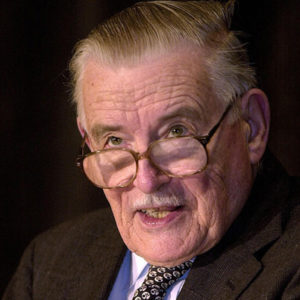James M. Buchanan won the Nobel Prize in 1986. Shortly after that, the Buchanan House at George Mason University was constructed to serve as both an office and an archive of Professor Buchanan’s life work. There were also the Collected Works projects that were undertaken at the Buchanan House – first Professor Buchanan’s 20 volumes (published between 1999 and 2001) and then Professor Tullock’s 10 volumes. Classes and seminars were regularly conducted in that building. Professor Buchanan was housed there, as were some graduate students and visiting scholars.

A memorandum of agreement was signed between Buchanan and the GMU Libraries to professionally handle Buchanan’s papers and memorabilia, but Buchanan never really retired, so the Buchanan House remained a working office, which meant that what was required for professional processing of papers could not be conducted, and his papers, library, and memorabilia remained basically in a state of limbo from 1990s to 2014. In January 2014, the Buchanan House activities were shut down and all Buchanan’s material from Blacksburg and Fairfax was combined and the professional processing began. The task that the archivists faced was monumental and the work they accomplished is nothing short of heroic.
Scholars depend on the professional work of librarians and archivists; we simply could not do our work without the dedicated work done by these individuals. So myopic are we that we rarely take time out to acknowledge this fundamental fact, except perhaps the occasional line in the preface of our books.
James Buchanan was in a unique place to provide an alternative “window” into the evolution of modern economics. He was part of the last generation of economists where verbal reasoning existed side-by-side with formal modeling and statistical analysis. The Samuelsonian revolution was just starting, along with the Keynesian avalanche in economic research and graduate education. Buchanan sensed this transformation while still a graduate student and devoted considerable effort throughout his career in resistance. He was educated at an elite institution – the University of Chicago – and worked with arguably the most respected American economist in the first half of the 20th century, Frank Knight (as well as an emerging superstar, Milton Friedman). Buchanan’s first papers directly challenged the work of Kenneth Arrow and Paul Samuelson. His contributions to public economics – forged during WWII and immediate post-WWII era – led to the development of public choice and constitutional political economy.
One of his key insights was that even the most technical of economics cannot be done without serious philosophical considerations. One cannot do public finance, for example, without first developing a theory of the state and its appropriate functions. Similarly, one cannot do political philosophy without postulating a realistic theory of public finance – what is to be produced, who is to produce, and how it is going to be paid for. The discipline as practiced by the classical political economists from Adam Smith to John Stuart Mill was practiced the way it was for very good reasons; the Samuelsonian promise of analytical precision was not enough to abandon that intellectual heritage.
In addition to public choice and constitutional political economy, Buchanan was a major contributor to the development of Law and Economics, market process economics, and property rights economics. While Milton Friedman’s monetarist counter-revolution against Keynesian economics would capture the headlines, it was Buchanan’s “genuine institutional economics” that provided the micro foundations for the counter-revolution to the neoclassical synthesis and market-failure theory. For this, Buchanan would win the Nobel Prize a decade after Friedman had won his. We now have access to the record of this intellectual/scientific revolution, and what a great opportunity that offers to each of us in the community of economists and political economists.
Buchanan was a meticulous record keeper; he had a sense of who and where he was from an early age, so he kept materials rather than discarded them, such as his lecture notes from Knight’s first class in price theory. Even though he moved often – Chicago, Tennessee, Florida State, Virginia, UCLA, Virginia Polytechnic Institute, GMU and in between visiting positions in Italy and in the UK – his materials remained, and he had the good fortune of having a very dedicated and skilled personal secretary for over 50 years in Betty Tillman. Buchanan’s archives contain correspondence, drafts of papers, referee reports pertaining to Buchanan’s papers, plans for projects, grant applications, and educational ventures to advance the counter-revolution methodologically, analytically, and ideologically. We have available to us a “window” into the inner workings of the scientific disciplines of economics, political science and philosophy. It is a fascinating journey from 1949 to 2014.
In August 2012, I attended a lecture by my former professor – James M. Buchanan. At the time he was 93 and would turn 94 that October. After his talk, we were casually chatting and I simply asked him, “Jim, how are you doing?” Never one for small talk, he just looked at me and said, “Well, I am not happy with that paper I just gave. I need to go home and do some revising.” With that he walked away to no doubt go home and do some revising. 93 years old, still thinking, still working on his craft as a writer, still revising to improve his thinking and his prose. This unquenchable thirst for knowledge, and his lifelong learning is evident throughout this archive. He was an inspired thinker, and an inspiring teacher, scholar, and academic entrepreneur. And he offers a unique window into our discipline that is so fascinating to peer through.
Peter J. Boettke is University Professor of Economics & Philosophy, George Mason University,


READER COMMENTS
David Henderson
Mar 13 2024 at 1:09pm
Beautifully said. I miss Jim.
Richard W Fulmer
Mar 13 2024 at 2:34pm
His archives will be an amazing resource for decades to come.
Comments are closed.